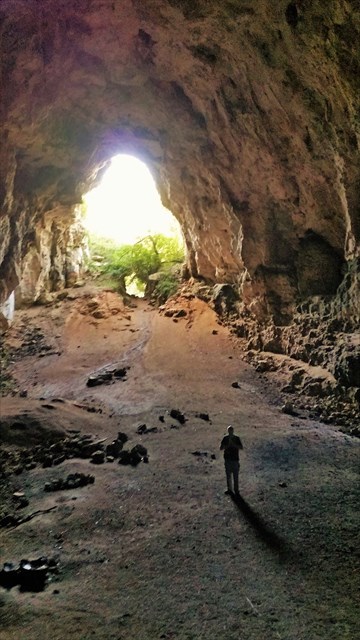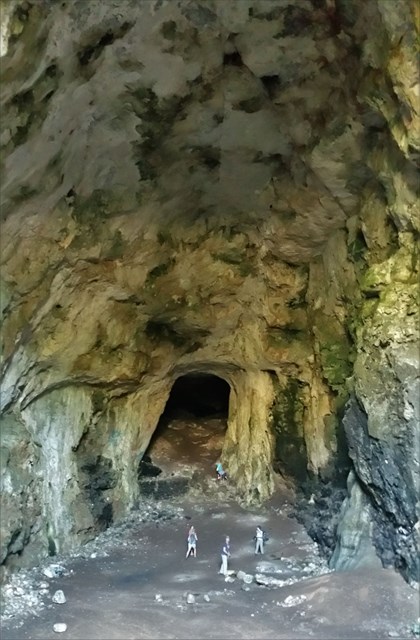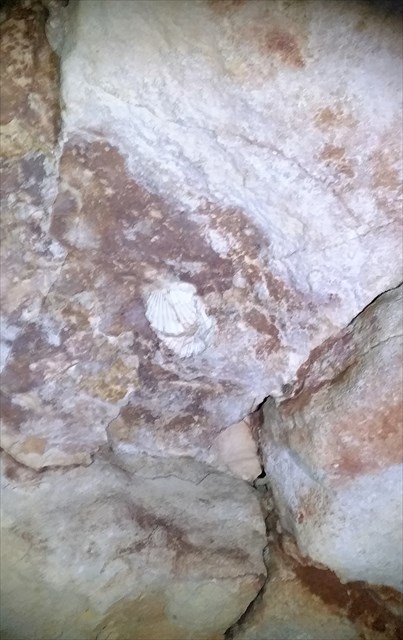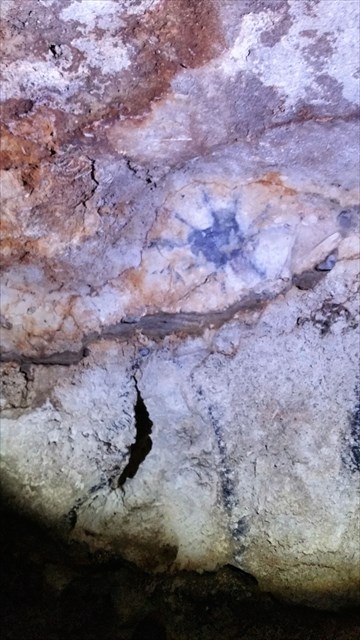La Cova des Coloms


Cova des Coloms Banner "for copy"
<a href="https://coord.info/GC6V21G" target="_blank"><img border="0" src="http://www.fotos-hochladen.net/thumbnail/2my0bfnesoi_thumb.jpg" /></a></p>
-------------------------------------------------------------------------------------------------------------------------------------------------------

Cova des Coloms,
also know as "The Cathedral" due to his extraordinary dimensiones is a natural cave, oriented to the eastern cliff of the Binigaus ravine.
The cave was probably used for ritual and funeral purpose.
Its roof rises 24m above the ground, it is 110m depth and 15m width.
It consists of an initial room, which narrows considerably.
The human presence and stealing attemps unfortunately can be seen in the archaelogical sediments of the main room.
Emilie Cartailhac published the discovery of human bones and pottery.
The pigeons that gave name to the cave have disppeared because of the hunters.
However there are still bats which, together with the mosses and lichens that cover the walls, give mysterious look to the cave.
(This text is from information sign in front of the cave!)
Because Menorca raised from the sea there are fossils of marine animals here (Mussels, snails, ammonites, etc.)
Menorca is geologically the eastern part of the betonic cordillera, a mountain range, which reaches from north of Africa over southern Spain, then downwelled into the Mediterranean Sea, to come to surface as Baleares again.
Through the influence of hugh tectonic forces the ancient sea Thetys was sqeezed 60-70 million years ago,
folded and raised to mountain ranges.
Menorca's rocks are from the ground of the sea and about 200-250 million years old.
The whole base of this island and the mountain ranges consists therefore of this primeval biogenic sediments of limestone.
That's why I discovered some mussels fossils in the limestone rock while exploring this cave.
These fossils are remnants and traces of prehistoric plants and animals that have been preserved in layers of earth.
When living creatures die, their bodies often rot without leaving any traces,
But if the conditions are favorable, some parts can be preserved.
The animal must be covered as quickly as possible with sand, mud, so that the air supply is stopped.
Then the hard components remain in the rock.
When the rock is removed by water and wind,
The animals appear as fossils again,
After they were hidden for thousands of years or millions of years.
1. What rock is the cave made of?
2. Straighten your flashlight in the back cavity on the ceiling. What can you discover?
(Use only the Infotafel in front of the cave to answer the questions below.)
3. In what years was Antonio Vives y Escudero in the cave?
4. What was the age of the C14 method?
5. What has disappeared by hunting?
Optional: Take a picture of yourself or you GPS in the cave
-----------------------------------------------------------------------------------------------------------------------------------------------------------------------------------------------

Cova des Coloms
---------------------------------------------------------------------------------------------------------------------------------------------------------------------------------------------------

Die Cova des Coloms
trägt wegen ihrer Ausmaße unterandern den spanischen Beinamen "La Catedral"
Sie ist eine natürliche Höhle und beginnt an der östlichen Klippe der Binigaus Schlucht.
Vom Boden bis zur Decke gemessen sind es 24m hoch, 110m tief und 15m breit.
Der Komplex besteht aus einem Raum, der sich nach hinten über einen Absatz erheblich verengt.
Die Höhle wurde früher wahrscheinlich für Rituelle- und/oder Bestattungszwecke verwendet.
Bei archäoligischen Grabungen in verschiedenen Schichten in der Haupthalle gab es viele Fundstücke,
die die frühere menschliche Präzens aufzeigten.
Veröffentlicht wurden die Entdeckungenen der Fundstücke aus menschlichen Knochen und Töpferein von Emilie Cartailhac.
Die Tauben, die der Höhle ihren Namen gaben, sind wegen ständiger Bejagung leider verschwunden.
Allerdings gibt es dort noch Fledermäuse, Moose und Flechten an den Wänden zu sehen.
(Dieser Text ist vom Informationsschild vor der Höhle!)
Wissenwertes:
Da Menorca sozusagen dem Meer entstiegen ist, lassen sich auch hier Fossilien von Meerestieren,
Muscheln, Schnecken, Ammoniten usw.finden.
Die Insel ist geologisch gesehen der östliche Teil der Betonischen Kordillere,
einem Gebirgszug, der von Nordafrika über Südspanien reicht und dann im Mittelmeer versinkt,
um als Balearen wieder an die Oberfläche zu kommen.
Durch die Einwirkung gewaltiger tektonischer Kräfte wurde das Urmittelmeer (Thetys) vor 60-70 Millionen Jahren stark gequetscht,
gefaltet und damit zu Gebirgen angehoben.
Menorcas Gesteine stammen vom Grund dieses Meeres und sind ca. 200-250 Millionen Jahre alt
und bestehen demnach aus urzeitlichen biogenen Kalksedimenten.
Deswegen habe ich beim Erforschen dieser Höhle einige Muschel Fossilien im Kalkstein entdeckt.
Diese Fossilien sind Reste und Spuren vorzeitlicher Pflanzen und Tiere, die in Erdschichten erhalten sind.
Wenn Lebewesen sterben, verfaulen ihre Körper oft ohne irgendwelche Spuren zu hinterlassen,
aber wenn die Bedingungen günstig sind, können auch manche Teile erhalten bleiben.
Das Tier muss möglichst schnell mit Sand, Schlamm bedeckt werden, damit die Luftzufuhr gestoppt wird.
Dann bleiben die harten Bestandteile im Gestein erhalten.
Wenn das Gestein durch Wasser und Wind wieder abgetragen wird,
kommen die Tiere als Fossilien wieder zum Vorschein,
nachdem sie Jahrtausende oder Jahrmillionen lang verborgen waren.
1. Aus welchem Gestein besteht die Höhle?
2. Leuchte mit deiner Taschenlampe in der hinteren Höhle an die Decke . Was kannst du entdecken?
(Benutze zum Beantworten der nachstehenden Fragen nur die Infotafel vor der Höhle.)
3. In welchen Jahren war Antonio Vives y Escudero in der Höhle?
4. Welches Alter wurde mit der C14-Methode belegt?
5. Was ist durch die Jagd verschwunden?
---------------------------------------------------------------------------------------------------------------------------------------------------------------------------------------------------------

Tropfstein
--------------------------------------------------------------------------------------------------------------------------------------------------------------------------

Sa Cova des Coloms,
también conocida como "La Catedral", por sus extraordinarias Dimensiones, es una gruta natural abierta al acantilado oriental del Barranco de Binigaus.
Que probablemente fue utilizada con fines
rituales y/o funerarios.
Su techo se eleva 24m por encima del suelo, tiene una longitud de 110 metros y 15 metros de ancho.
Esta formada por sala incial de 50 metros de largo y otra sala interior que se va estrechando y pierde altura.
En la sala principal hay sedimentos arqueologicos que han sufrido diferentes intervenciones y algunas catas clandestinas.
Emilie Cartailhac publicó el hallazgo de huesos humanos y cerámicas.
Las palomas que dieron nombre al lugar han desaparecido a consecuencia de los cazadores.
No obstante aun habtian en ella murciélagos que, junto con el musgos y los líquenes que cubren las paredes,
dan un aspecto misterioso a la cueva. (Este texto es signo de la información frente a la cueva!)
Por así decirlo, ya que Menorca surgió del mar, se pueden encontrar aquí fósiles de animales marinos (mejillones, caracoles, amonitas, etc.).
La isla se encuentra geológicamente en la parte oriental de la cordillera betónica, una cadena montañosa que se eleva desde el norte de África pasando por el sur de España y que después se sumerge en el mar Mediterráneo para volver a elevarse a la superficie en las Baleares.
Debido a la acción de las inmensas fuerzas tectónicas, hace 60-70 millones de años el antiguo mar Mediterráneo (Tetis) fue apretado intensamente, doblado y con ello elevado a las cadenas montañosas.
Las rocas de Menorca provienen del fondo de este mar y tienen aproximadamente de 200 a 250 años de antigüedad y por lo tanto están hechas de sedimentos de cal biogénicos y prehistóricos.
Por ese motivo he descubierto al explorar estas cuevas algunos fósiles de mejillones en piedra caliza.
Estos fósiles son restos y huellas de plantas y animales prehistóricos que se han conservado en los estratos. Cuando los seres vivos mueren, sus cuerpos se descomponen a menudo sin dejar ningún rastro, pero si las condiciones son favorables, también se pueden preservar algunas partes. El animal debe ser cubierto lo más rápidamente posible con arena y barro para que el suministro de aire sea detenido. Entonces los componentes duros permanecen en la roca. Cuando la roca se va desgastando de nuevo por la acción del agua y el viento, los animales salen de nuevo a la luz como fósiles, después de haber estado ocultos durante miles o millones de años.
1 – ¿De qué roca está hecha la cueva?
2 – Alumbre el techo de la cueva posterior con la linterna. ¿Qué se puede descubrir?
---------------------------------------------------------------
(Utilize solamente la información de la pizarra que se encuentra a la entrada de la cueva para responder las siguientes preguntas)
3 – ¿En qué años estuvo en la cueva Antonio Vives y Escudero?
4 – ¿Qué edad fue datada con el método del C14?
5 – ¿Qué ha desaparecido a causa de la caza?
Opcional: Hágase una foto en la cueva
--------------------------------------------------------------------------------------------------------------------------------------------------------------------------


Fossilien
